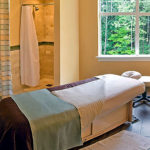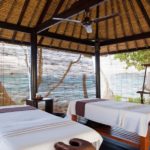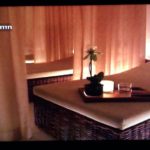Massage is (key) for arousal, relaxation, sports medicine, therapy, and wellness. Because of this, it is counted as a core-subject/curriculum here in our educational system. Every student has this chance to become a basic masseuse by graduation.
–
Table of Contents:
- Basics
- Vocabulary
- Some Test Questions
- Progression
- Example Images
–
Basics:
Muscle Groups:
- Abdominal external oblique (ribs/sides/waist)
- Biceps (front of upper arms)
- Calves
- Cardiac
- Deltoid (shoulder)
- Erector spinae (back)
- (face muscles)
- (feet muscles)
- Gluteal (butt)
- Hamstrings (upper legs)
- (hand muscles)
- (internal muscles, such as sphincters)
- Latissimus dorsi (back)
- (neck muscles)
- Pectorals (chest)
- Quadriceps (front of upper legs)
- Rectus abdominis (abs)
- (scalp muscles)
- Trapezius (between shoulders and neck)
- Triceps (back of upper arms)
Massage Styles:
- Acupressure
- Aromatherapy
- Ayurvedic
- Chair
- Craniosacral Therapy
- Deep Tissue
- Friction
- Hot Stone
- Manual Lymphatic Drainage
- Myofascial Release
- Neuromuscular
- Prenatal
- Reflexology
- Reiki
- Shiatsu
- Sports
- Stretching
- Swedish
- Tapotement
- Thai
- Trigger-point
- Vibration
–
Vocabulary:
- Abduction: The movement which separates a limb or other part from the axis, or middle line, of the body.
- Adduction: The movement of a limb or other body part, usually on a transverse plane, toward the axis or midline—medial plane—of the body.
- Adipose: or body fat or just fat is loose connective tissuecomposed mostly of adipocytes. Its main role is to store energy in the form of lipids, although it also cushions and insulates the body. Far from hormonally inert, adipose tissue has, in recent years, been recognized as a major endocrine organ,[
anterior: nearer the front, especially situated in the front of the body or nearer to the head. “the veins anterior to the heart” - Aorta: the main artery of the body, supplying oxygenated blood to the circulatory system. In humans it passes over the heart from the left ventricle and runs down in front of the backbone. TI-L2
- Artery: The arteries are the blood vessels that deliver oxygen-rich blood from the heart to the tissues of the body. Each artery is a muscular tube lined by smooth tissue.
- Each artery is a muscular tube lined by smooth tissue and has three layers:
–1. The intima, the inner layer lined by a smooth tissue called endothelium
–2. The media, a layer of muscle that lets arteries handle the high pressures from the heart
–3. The adventitia, connective tissue anchoring arteries to nearby tissues - Arthritis: Inflammation, pain, swelling, stiffness of the joints
- Axial: bones of one’s trunk (skull, spinal column, ribs, sternum, clavicle, etc)
- axillary: axill, ary
–armpit, pertaining to - Axon: A long, slender tube, often covered by a myelin sheath – carries information from the cell body to the terminal buttons
- autonomic: function: conducts impulses that affect activities of the organs, vessels, and glands
–type of control: involuntary
–tissue stimulated: cardiac muscle, smooth muscle, and glands - Bursae: An extension of outpouching of the synovial membrane of a diarthrodial joint
–Filled with synovial fluid and usually exist in areas of potential stress to help absorb force and protect periarticular connective tissues, including bone - Brachii: “two-headed [muscle] of the arm”, in reference to the fact that the muscle consists of two bundles of muscle, each with its own origin, sharing a common insertion point near the elbow joint.
–examples: Biceps Brachii and Triceps brachii - Biceps Brachii: O: coronoid proc (short), Supraglenoid tubercle –(LH) I: Tuberosity of radius, bicipital aponeurosis A: flex shoulder, assist ABD (LH), flex elbow & supinate. N: Musculocutaneous, ( C5,6)
- Triceps brachii: origin tubercle below glenoid cavity and lateral and medial surfaces of humerus
–insertion olecranon process of ulna - Carbohydrate: Energy-rich organic compound made of the elements carbon, hydrogen, and oxygen. Monomers: Monosaccarides(Carbon-2 hydrogen- oxygen (glucose) Polymers: disaccharides and polysaccrides Source of energy which is found in food Quick energy
- cartilage: connective tissue that is elastic
- Circulatory: Structure: Heart, blood vessels
–Function: transports nutrients and oxygen to cells, removes watse molecules that are excreted from body - Collagen: all multicellular organisms contain collagen
–most abundant protein in mammals (25% of total mass of protein)
–skin, bone, teeth, tendons, cartilage, and blood vessels use collagen as major fibrous element
–around 1/3 glycine (every third residue) - Compression: is rhythmic pressing movements directed into muscle tissue by either the hand or fingers.
- Coronal: Divides body into anterior and posterior. front to back.
- Cranial: Toward the head, or upper part of the body
- Deltoid: O/lateral one-third of clavicle,acromion,spine of scapula.I/deltoid tuberosity
–A/abducts shoulder-flex,medially rotate shoulder,N/axillary from brachial
–plexius
–triangle-shaped deltoid located on cap of the shoulder - What are the three layers of the skin? 1. epidermis –2. dermis -papillary layer -reticular layer –3. subcutaneous
- Dorsal: toward or at the backside of the body; behind
- Dorsiflexion: Bringing the toes and top of the foot up toward the shin (flexing the foot)
- edema: fluid being held in the subcutaneous (underlayer) tissues of your skin. Your lymph system is what filters, and rids your body of this excess fluid. But when something is wrong, the body can’t get rid of this fluid like it’s supposed to. Therefore you get the swelling, most commonly in the feet and lower legs.
- inflammation: swelling of the top layer of your skin. For example if you get cut, and it’s red and swollen all around. But there’s generally not a collection of fluid causing the swelling.
- effleurage: a soft, continuous stroking movement applied with the fingers and palms in a slow and rhythmic manner, encourage lymph flow towards the heart.
- epinephrine: also known as adrenalin. causes:
–fight or flight response - estrogen: one of the group of hormones that stimulate the growth of reproductive tissue in females
- eversion: movement of the sole of the foot outward away from the midline
- Excretory: Kidney, Ureter, Bladder/ Urethra
–Function: Eliminates Liquid wastes; regulates water balance - extensor: a muscle whose contraction extends or straightens a limb or other part of the body.
–Ex: tricep, extensor carpi ulnaris, and extensor digitorum. - Fascia: Fibrous dense sheet like tissue that surrounds/separates organs and muscles
- fibrosis: Excessive deposition of collagen and ECM components (excessive scarring) following a prolonged or chronic injury
- fibrous: the name for a joint that does not allow any movement
- ganglia: is a nerve cell cluster or a group of nerve cell bodies located in the peripheral nervous system. Cells found in a ganglion are called ganglion cells, though this term is also sometimes used to refer specifically to retinal ganglion cells.
- Groin: Is the front surface of the body marked by a crease on each side, where the trunk attaches to the thigh. Made up of the adductors:
–1. Pectineus 2. Adductor Magnus 3. Adductor Longus 4. Adductor Brevis 5. Gracilis - hemoglobin: Hemoglobin; also spelled haemoglobin and abbreviated Hb or Hgb, is the iron-containing oxygen-transport metalloprotein in the red blood cells of all vertebrates as well as the tissues of some invertebrates.
- homeostasis: it is maintenance of a stable internal environment; a dynamic state of equilibrium; necessary for normal body functioning and to sustain life
- Hormone: chemical secreted by a cell or group of cells into the blood for transport to a distant target where it acts in very low concentrations to affect growth, development, homeostasis, or metabolism
- ileocecal: the valve at the junction between the ileum and the cecum of the asceding colon
- iliac: upper curved edge of the ilium or pelvic bone
- Insomnia: People who do not sleep well, wake up frequently, or cannot fall asleep. EEGs show: these people do sleep, but don’t benefit from the restorative properties. General factors: anxiety, environment, etc. Associated disorders
- inversion: movement of the sole medially at the tarsal joints (inside of your foot is of the ground)
- Involuntary: action that you can’t control. Smooth muscle and cardiac muscle are involuntary muscles.
- kneading: the rhythmic pressing movements directed into muscle tissue by either the hand or fingers
- latissimus: origin: spinous processes of thoracic T7-L5 insertion: floor of intertubercular groove of the humerus Innervation: thoracodorsal nerve main action: extends, adducts arms
- lesion: any abnormality in the tissue of an organism (in layman’s terms, “damage”), usually caused by disease or trauma.
- ligament: mostly elastin and very stretchy
–connects bone to bone or cartilage to cartilage
–holds joints together
–usually allows movement or stretching in one direction - lumbar: an adjective that means of or pertaining to the abdominal segment of the torso, between the diaphragm and the sacrum (pelvis). The lumbar region is sometimes referred to as the lower spine, or as an area of the back in its proximity.
- Lymph: A clear fluid collected from tissues and transported by vessels to venous circulation
- LYMPHATIC: MAJOR ORGANS: -SPLEEN, -THYMUS, -LYMPHATIC VESSELS, -LYMPH NODES -TONSILS. –FUNCTIONS: -DEFENDS AGAINST INFECTION AND DISEASE -RETURNS TISSUE FLUIDS TO THE BLOODSTREAM
- Menisci: fibrocartilage pads located between the tibial and femoral condyles. These reduce friction between the articulating bones
- metastasis: secondary tumor that appears when cancerous cells spread to other parts of the body
- Midline: imaginary mid-line diving the body into equal right and left halves
- Neuron: Highly specialized cell that communicates info in electrical and chemical form: nerve cell
–makes up the nervous system - passive: ions move from high concentration to low concentration.
- Pancreas: The pancreas is an endocrine organ that lies in the abdomen, specifically the upper left abdomen. It is found behind the stomach, with the head of the pancreas surrounded by the duodenum.
–It is an endocrine gland producing several important hormones , including insulin , glucagon , somatostatin , and pancreatic polypeptide which circulate in the blood. The pancreas is also a digestive organ, and aids in digestions - Percussion: Tapping patient’s skin with short, sharp strokes to assess underlying structures
–Used to assess organ size
–Assesses for density (air, fluid, or solid)
–Elicits pain if underlying structure is inflamed
–Elicits deep tendon reflexes - Petrissage: Kneading movement that stimulates the underlying tissues; performed by lifting, squeezing, and pressing the tissue with a light, firm pressure.
- Phalanges: 14 finger bones. Also called digits. Each digit contains 3 bones except for the thumb.
- phlebitis: The inflammation may cause pain and swelling. When the inflammation is caused by a blood clot or thrombus, it is called thrombophlebitis. Thrombophlebitis usually occurs in leg veins, but it may also affect the veins in the arms.
–if have blood clots. massage is not advised - Pineal: Smallest endocrine gland in body; size of grain of rice
–Shape of pine cone
–Produces melatonin; involved in sleep cycles and seasonal rhythms
–Similar cells to retinal photoreceptors - Pituitary: Master controller of the body’s endocrine system -Hypophysis: base of brain -2 distinct gland -Different embryological origins -HHPS in all but the most primitive vertebrates -Anterior and posterior pituitary
- Plantarflexion: Bends foot and toes toward the ground, like when you stand on your toes.
- Platelets: Cell fragments that assist in blood clotting
- Popiteal: Dorsal knee (back of the knee)
- preeclampsia: a disorder that can arise in the latter half of pregnancy, marked by swelling in the ankles and other parts of the body, high blood pressure, and protein in the urine; can progress to coma and death if not treated.
- pylorus: The main functions of the pylorus are to prevent intestinal contents from reentering the stomach when the small intestine contracts and to limit the passage of large food particles or undigested material into the intestine.
- quadratus: descriptive of muscles that are square or four-sided
- Rectum: Final part of the large intestine. It is short straight segment that lies between the sigmoid colon and the anus
- respiratory system: The respiratory system is a biological system consisting of specific organs and structures used for the process of respiration in an organism.
- Sacrospinalis: o. sacrum, iliac crest, spinous processes of lumbar vertebrae
–i. cervical vertebrae or upper thoracic vertebrae. a. extension with bilateral contraction and later flexion with unilateral, same side contraction of vertebral column - Sagittal: down the middle of your head
–midsaggital= right down central
–parasagittal= any other sagittal slice
–seperates into medial/lateral =left/right - Salivary: Sympathetic effect: decreases –Parasympathetic effect: increases
- Scapula: Elevates, depression, protraction, retraction, rotation
- Sensory: type of neurons that send afferent signal
- skeletal: provide framework, protect soft tissues, provide attachments for muscles, produce blood cells, store inorganic salts
- somatotropic: growth hormone- given to children who aren’t normal size causes hypercalcemia and kidney stones given 3-7 times a week
- superficial: structure close to the surface of the body
- synapse: In the nervous system, a synapse is a structure that permits a neuron to pass an electrical or chemical signal to another cell.
- Tapotement: A type of massage; the body is tapped in a rhythmical manner with the side of the hand or tips of the fingers using rapid, repetitive movements
- Temporal: Primary hearing center; speech/memory
- testosterone: hormone. –1. supports the developing of spermatozoa –2. supports the growth and function of cells that make up the repo tact.
- Thymus: Site of T cell development during childhood -Destroys self-specific T cells so they don’t attack body’s own normal molecules
–Hassal’s corpuscles – distinguishing feature; have concentric epithelioreticular cells and produce thymic hormones
–parenchyma has developing T cells - thyroid: found in the neck; controls metabolism
- transverse: divides body in superior and inferior halves
- Ulnar: mixed
–origin-medial cord
–skin of palmar & med. hand, digits III-V, elbow & hand joints
–adductor pollicis, some fore. flexors, hyppthenar group, interosseous’s, lumbricals III-IV - ventral: means same as anterior only in humans, refers to the belly or “underside”
- vertebral: posterior part of head
–
Some Test Questions:
- what is the massage stroke that consists of manipulations that press and roll the muscles under the hand?
–petrissage - Skeletal muscles normally work (A) in groups. (B) one at a time. (C) autonomically. (D) isometrically
–(A) in groups. - All of the following are appropriate goals of massage therapy EXCEPT to (A) relieve pain. (B) ease the symptoms of injury or disease. (C) ease the symptoms of tension and fatigue. (D) medically treat physical defects.
–(D) medically treat physical defects.
–
Progression:
Students in this class first learn all the muscle groups, then how to feel/identify their own, and later how to find and work them on others. No one is forced or pressured to learn full-body massage, tongue-based massage, or the use of “adult toys” in advanced massage. Those are just options for those wishing to go all the way (pun not intended).
self-massage
- basic muscle groups in easy-to-reach areas; biceps, quadriceps, etc.
- more-specific muscle-groups or individual muscles
- difficult-to-reach muscle-groups
- sexual muscle-groups
- combinations of non-sexual muscle-groups to achieve certain effects/healing
- combinations of non-sexual and sexual muscle-groups to achieve certain effects/healing
hands-based
- muscle groups
- deep tissue
- sports therapy/medicine
- sensual/sexual (without sex, but with penetration of the female)
tongue-based
- licking muscles / body-parts
- French-kissing to achieve certain effects (different techniques, such as touch-points, timing/duration, etc.)
cock/dildo-based
- using this and other sex-toys to massage a female’s internal muscle-groups; throat, vagina, and anal cavity
…
By School-year:
- Musculature
- Regular
- Deep Tissue
- Sports Medicine
- Holistic
- Sensual
- Tongue Baths
- Oral
- Sexual
- Kegels
- Swedish
- _TBA
- Exodus
- _
- _
- Symphonic, Group
…
reference: wiki
–
–
video






